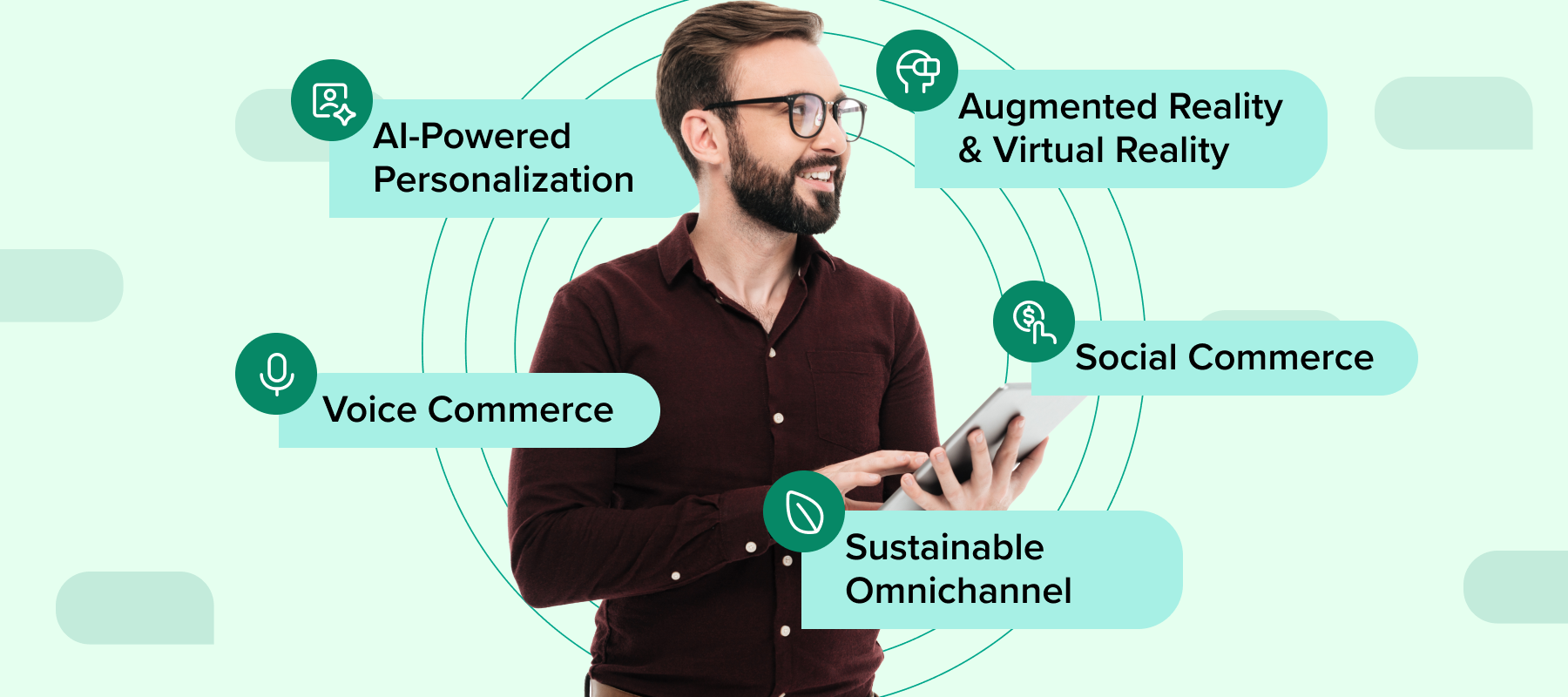The modern consumer wants the convenience of digital shopping with the familiarity of in-person experiences, prompting businesses to rethink their engagement models. Take Nike, for instance. It is one of the pioneering brands to introduce omnichannel retail with the concept of curbside pickup, offering customers the flexibility of purchasing online and picking up their orders at a preferred location. A unified approach, such as Nike’s, can skyrocket product sales while fostering customer loyalty at scale. In fact, marketers who leverage three or more channels for a campaign saw their purchase rate soar as high as 287% compared to those who employed single-channel campaigns, according to Omnisend.
As businesses prepare for 2025, several trends are set to redefine the omnichannel experience. In this article, we’ll unpack the top omnichannel trends for 2025 (and possibly beyond).
Top Omnichannel Trends for 2025
1. AI-Powered Personalization
AI-powered personalization is redefining how businesses deliver tailored experiences across multiple touchpoints. AI helps analyze vast amounts of customer data in real time, predict behaviors, and deliver content and offers that align with individual preferences and needs. This level of personalization enhances engagement and builds trust, turning one-time buyers into loyal brand advocates.
For example, AI-driven systems can recognize when a customer interacts with a brand on social media, then recommend relevant products through email or push notifications, maintaining a consistent and personalized journey. According to McKinsey, companies can achieve a 5-15% increase in revenue if they get omnichannel personalization right.
In 2025, AI’s ability to integrate data across channels and ensure a seamless flow of interactions, will help businesses eliminate silos that previously hindered customer experiences.
2. Voice Commerce
Voice commerce is widely recognized as the next major omnichannel trend, allowing consumers to make purchases, search for products, and interact with brands through voice-enabled devices. Its popularity is driven by the convenience it offers, allowing hands-free shopping and real-time responses to queries.
Buyers can reorder products, add items to their cart, or even complete transactions with simple voice commands. In fact, more than 50% of online searches could be through voice by 2025, implying that it’s one of the main ways people will shop in the near future.
As voice assistants become better at understanding natural language and contextual cues, the personalization capabilities of voice commerce are improving. These advancements enable businesses to recommend products, provide tailored deals, and address customer inquiries more effectively, enriching the overall shopping experience.
It is no secret then that businesses must optimize their content for voice search, ensuring seamless integration with voice-enabled platforms and aligning it with their broader omnichannel strategy to drive engagement and sales.
3. Augmented Reality (AR) and Virtual Reality (VR)
It is safe to say that AR and VR are the future of omnichannel retail, offering immersive shopping experiences that increase purchase confidence and significantly reduce returns. Brands like IKEA and Sephora use AR apps to let customers visualize products in their homes or virtually try on makeup.
AR allows shoppers to visualize how products (furniture, clothing, or accessories) will look in their homes or on their bodies, bridging the gap between the online and in-store shopping experience.
Similarly, VR creates fully virtual shopping experiences where customers can explore virtual showrooms or simulate real-world environments to experience a product’s features in detail. This makes online shopping more interactive, while fostering a connection to the product that traditional images or videos simply can’t replicate.
According to a Deloitte report, 71% of shoppers would consider shopping more often if AR apps are available, while a healthy 40% are prepared to pay more for a product if they can test it using AR. As these technologies evolve, their integration into omnichannel strategies will only grow, making them a critical component for any retailer aiming to stay competitive in the digital age.
4. Social Commerce
Social commerce blends eCommerce with social media platforms, allowing consumers to shop directly from social networks like Instagram, Facebook, TikTok, and Pinterest. This trend capitalizes on the growing influence of social media in everyday life and the rising demand for a seamless shopping experience across digital touchpoints. An Accenture study states that, by 2025, 17% of all eCommerce spends will be done through social commerce, with apparel, consumer electronics, and home decor leading the number of purchases made globally.
The ability to showcase products in an organic, contextual manner makes the shopping experience feel less transactional and more engaging. As influencers and user-generated content (UGC) drive buying decisions, businesses that embrace social commerce will benefit from increased visibility and deeper customer connections.
What makes social commerce particularly effective is that buyers, rather than navigating away from their social channel to complete a purchase, can transact within the channel, which aligns with the consumer’s need for convenience and personalization.
5. Sustainable Omnichannel
Sustainability is no longer an option but a business imperative, and it’s now influencing omnichannel strategies. From eco-friendly packaging to carbon-neutral supply chains, businesses are aligning their operations with the values of environmentally conscious consumers.
A NielsenIQ survey found that 73% of global consumers are willing to change their consumption habits to reduce environmental impact.
Brands like Patagonia and IKEA are integrating sustainability into their omnichannel models, offering options like in-store recycling and digital solutions for reducing waste.
In 2025, sustainability will not just be an add-on, it will be a defining trait of successful omnichannel strategies.
Implementing an Effective Omnichannel Strategy
Implementing an effective omnichannel strategy in 2025 requires a combination of technologies and customer insights to ensure a seamless experience across touchpoints.
Find your ideal customer & choose the right channels
For a high-impact omnichannel strategy, begin by identifying your ideal customer. Segment your audience based on data from various sources (website analytics, social media interactions, or past purchase behavior). This will help you gain deeper insights into customer preferences, behaviors, and pain points.
Once you’ve gathered this information, choose the right channels to reach your target audience. Whether it’s mobile, email, social media, or in-store experiences, understanding where your audience spends the most time is critical for engagement.
Finally, map the customer journey by tracking how customers move through various touchpoints. This helps you identify any gaps in the experience and optimize each stage of the journey, from discovery to purchase and beyond. By visualizing this process, businesses can design seamless transitions and ensure a unified experience, improving conversion rates and customer satisfaction.
Embrace AI and data integration
Businesses that integrate AI tools can optimize everything from personalized marketing campaigns to inventory management, ensuring a more efficient, seamless experience across both online and offline channels.
Data should flow seamlessly between the physical store, website, mobile app, or social media. The unified customer view enables smarter decision-making and personalized engagement at scale. Businesses that use AI and data integration to bridge online and offline touchpoints will likely drive higher customer engagement and satisfaction.
Focus on seamless customer service across channels
Offering consistent, responsive customer service is a hallmark of a successful omnichannel strategy. Whether it’s through chatbots, customer service agents on social media, or in-store representatives, businesses need to ensure that customers receive the same high-quality support, no matter where or how they reach out.
Channels such as WhatsApp, integrated with AI-powered solutions, will allow for real-time, personalized support, enhancing both the customer experience and the business’ overall reputation.
Conclusion
As we look to 2025, omnichannel strategies are critical for businesses of all sizes. For small and medium-sized businesses (SMBs) and enterprises alike, embracing the right technologies and getting a deeper understanding of customers, is the key to maximizing the impact. Ultimately, omnichannel isn’t just about the tools or the channels you use. It’s about creating a unified experience, making each interaction intuitive, personalized, and seamless.








